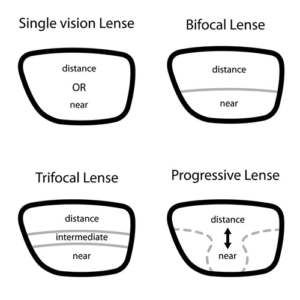Looking forward through glasses
New Zealand has a population of around 4.8 million people, and in 2020 the median age was 38. This basically means that half the people in New Zealand are younger than 38 and half are older. If you are in this top bracket, then either you already have, or probably very soon you will begin to realise that reading material is out of focus.
You may also realise that moving stuff further away to bring print into focus is no longer working. Presbyopia, also known as the “short arm syndrome” comes from the Greek meaning “trying to see as old men do”, catches up with most of us sooner or later, usually just after we turn 40. If you’re at all worried about changes in your vision, call 09 522 1283 to schedule a comprehensive eye test.
With lifespans increasing, there is a very good chance those of us who become presbyopes can look forward to spending almost half our lives in glasses.
What are progressive lenses?
Progressive lenses correct your vision at different distances: from reading distance to far distance. There is a continuous gradual change in prescription throughout the lens, so wearers no longer have to constantly take glasses on or off or ‘switch glasses’ for distance and near sight. No more lugging around more than one pair of glasses and swapping between reading glasses, glasses for driving and glasses for seeing a computer screen clearly. The distance vision in the lens is usually directly in front of the pupil, and the near vision in the lower part of the lenses.
As we age, our level of presbyopia also increases. (Arms get shorter and shorter.) So, an emerging presbyope, or newly affected 40+-year-old, may find single vision glasses with a boost in the lower half of the lens for near and intermediate work do the trick wonderfully, whereas a general progressive wearer might enjoy the addition an indoor-specific progressive lens for computer working distance.
All is not the same
Humans have binocular vision: vision produced by two eyes. Our eyes form images on our left and right retinae. Each eye sees the world from a slightly different perspective. The brain combines these left and right images into one clear image.
If the images are not equivalent in size or location, the brain will not be able to fuse the images fully, and in extreme cases, double images can happen. And, seven out of ten people have different prescription powers between left and right eyes.
Get the picture?
Basically, our eyes are different, our lens requirements are different and where, when and how we want to use progressive lenses differs.
Progressive lenses are not all created equal
What has Hoya done about this? They have worked for continuous advancements in progressive lens design technologies to improve progressive lens wearers’ optical experiences. Why? Primarily because progressive lens design is not a one-size fit all.
Hoya have created new iD Lifestyle 3 progressive lenses that are specific to different types of presbyope; the glasses we wear can change as we do.
iD Lifestyle 3 progressive lenses
LifeStyle 3 lenses provide clear, relaxed vision for all distances, as well as natural progression between near, intermediate and far. The iD FreeForm Design Technology™ is used to provide wider viewing zones and eliminate the virtual blurring effects.
Their cunning lenses also, very simply put, balance the power progression for both left and right lenses. And that means both eyes work together, regardless of prescription power differences, to form equivalent images on the left and right retinas.
With traditional progressive lenses that don’t cleverly compensate for prescription differences between eyes, the brain receives two different size images in two different locations, making it difficult to fuse the two images into one clear image. BHT, Binocular Harmonization Technology, provides a solution. It compensates for virtually all power differences between the two lenses as we look through the intermediate and reading power zones.
Clearer vision
Even though that explanation might not be clear, Hoya’s Binocular Harmonization Technology and iD dual side progressive lens design means your vision will be. A short conversation with one of our optometrists will quickly clear up any questions you have on the topic.
Clearer head
Their iD Lifestyle 3 progressive lenses maximise the field of view and minimise distortion while providing more natural eye rotation. (No more swaying sensation). Their progressive optics also make the transition between distance and near more seamless. The iD design provides optimal progression from the distance zone in the top of the lens to the near power zone in the bottom, while providing a wide usable intermediate area in the lens.
Unique advancements in vision technologies
HOYA believes that this is unique in the market. By balancing the difference between right and left prescriptions and employing patented Integrated dual side technology, their iD Lifestyle 3 progressive lenses are seen to provide unsurpassed visual performance.
Wear them your way
Today’s digital device use and outdoor activities require more than one pair and more than one progressive design to meet all of our lifestyle demands. iDLifestyle 3 provides the wearer with choices based on their lifestyle: Indoor, Urban and Outdoor.
Indoor places emphasis on near vision focus, Urban wearers enjoy equal focus on all main vision areas, and Outdoor puts its primary focus on distance. Have a chat with one of our optometrists to determine the design variation that is best suited to you.
Our opticians are always available for consultations. Call us on 09 522 1283 or 09 836 1731 and we’ll be happy to help! Between our Henderson optometrists and our optometrists in Newmarket our staff has dedicated over 35 years to helping Aucklanders through many a see change.

